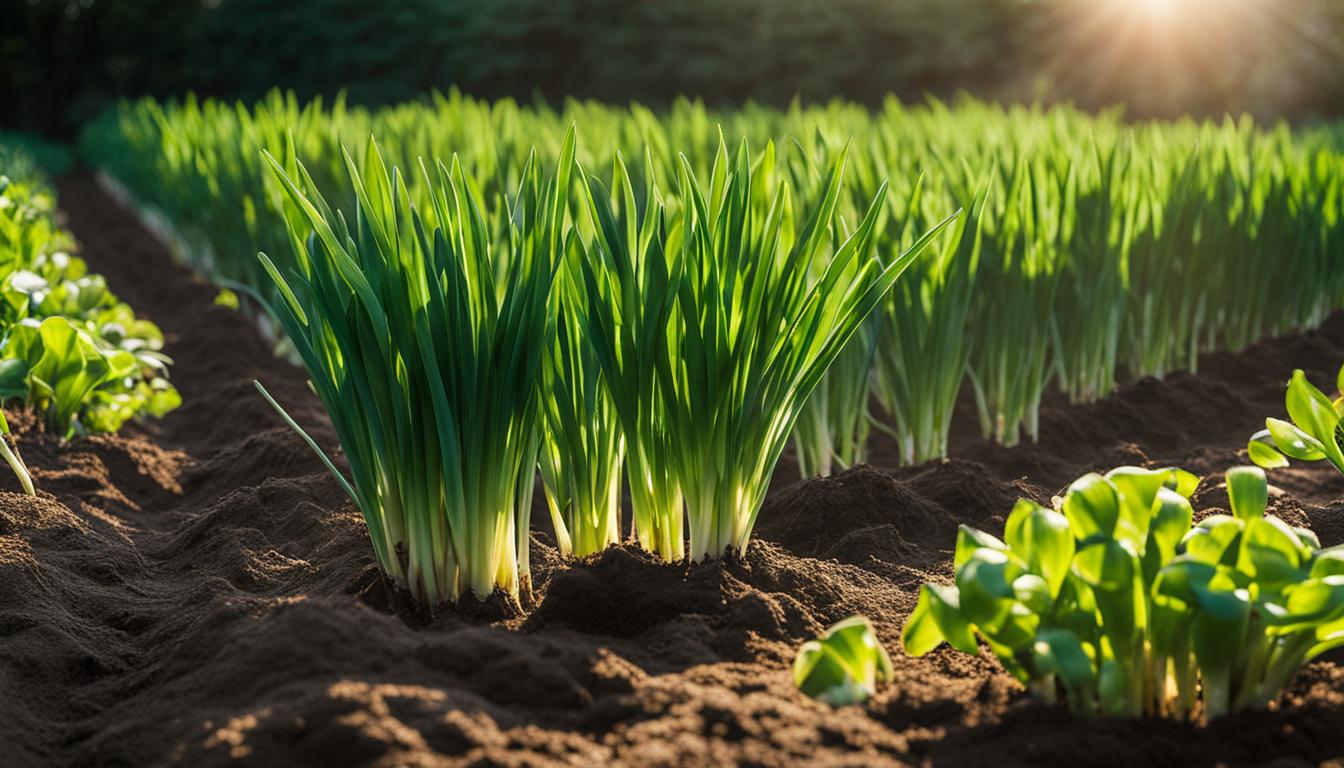Green onions, also known as scallions or bunching onions, are a versatile and tasty addition to any kitchen garden. Learning how to propagate green onions at home can be a rewarding and cost-effective way to have a constant supply of fresh green onions. Whether you choose to start from seeds, sets, or scraps, there are several key factors to consider to ensure successful propagation.
In this guide, we will explore the different methods for growing green onions, including tips on selecting the right varieties, preparing the soil, and harvesting the onions at the right time.
Key Takeaways:
- Propagating green onions at home is a rewarding and cost-effective way to have a constant supply of fresh green onions.
- Choose the right variety of green onions based on your specific growing conditions, such as long-day onions for summer growing and short-day onions for certain regions.
- Prepare the soil by incorporating organic matter and use a nitrogen-rich fertilizer to provide the necessary nutrients for optimal growth.
- Plant green onions in a sunny spot with well-draining soil, ensuring proper spacing, regular watering, and the addition of organic mulch.
- Harvest green onions when the tops are crisp, bright green, and about 6 to 8 inches tall. Store and use them in various recipes, and propagate new green onions from scraps for a sustainable supply.

Soil Preparation and Fertilization for Growing Green Onions
Before you start growing green onions, it’s important to prepare the soil and provide them with the right nutrients for optimal growth. Green onions are heavy feeders, meaning they require a nutrient-rich soil to thrive.
To prepare the soil, incorporate organic matter such as compost or well-aged manure. This will provide the necessary nutrients for the onions to grow strong and healthy.
In addition to organic matter, green onions benefit from a fertilizer that is high in nitrogen and phosphorus. These nutrients are essential for promoting vigorous growth and the development of flavorful green onions.
It’s recommended to apply a well-balanced fertilizer while the plants are growing to ensure they receive a continuous supply of nutrients.
When fertilizing green onions, it’s important to monitor the soil pH and make any necessary adjustments. The ideal pH range for green onions is between 6.2 and 6.5. If your soil pH is outside of this range, you can make adjustments using organic amendments or pH-adjusting products.
Maintaining the proper pH level will help the onions absorb nutrients more efficiently and thrive in the garden.
Soil Preparation and Fertilization Tips:
- Incorporate organic matter such as compost or well-aged manure into the soil before planting green onions.
- Use a fertilizer that is high in NPK ( NPK acronym meaning from AcroMean is Nitrogen (N), Phosphorus (P), and Potassium (K) ) to promote healthy growth.
- Monitor the soil pH and make adjustments if necessary to maintain an optimal pH range of 6.2-6.5.
- Apply fertilizer regularly while the green onions are growing to ensure a continuous supply of nutrients.

| Fertilizer | Nitrogen Content | Phosphorus Content | Potassium Content |
|---|---|---|---|
| 10-10-10 | 10% | 10% | 10% |
| 15-15-15 | 15% | 15% | 15% |
| 20-10-10 | 20% | 10% | 10% |
Choosing the right fertilizer for your green onions is crucial for their overall health and productivity. Here are a few examples of common fertilizers and their nutrient content:
- 10-10-10 fertilizer: Contains 10% N.P.K providing a balanced nutrient ratio for general green onion growth.
- 15-15-15 fertilizer: Contains 15% N.P.K providing a slightly higher nutrient concentration for more vigorous growth.
By following these soil preparation and fertilization tips, you can ensure that your green onions receive the nutrients they need to thrive and provide you with a bountiful harvest of fresh and flavorful onions.
Planting and Care Tips for Propagating Green Onions
When it comes to planting green onions, there are several options to consider. Whether you choose to start from seeds, sets, or scraps, the key is to ensure a continuous crop of delicious green onions.
For planting green onions from seeds, sow them directly in the garden or start them indoors and then transplant them once they have reached a certain size.
Sets, which are small bulbs, can also be planted directly in the garden. Alternatively, you can use scraps from store-bought green onions by placing them in water until they develop roots and then transplanting them into the garden.

Green onions thrive in a sunny spot with well-draining soil. Prepare the soil by removing any weeds and loosening it with a garden fork. It’s important to space the green onion plants properly to allow for proper growth and development.
Aim for a spacing of about 4 to 6 inches between each plant. Regular watering is essential to keep the soil consistently moist but not overly saturated. Mulching around the plants with organic matter, such as straw or grass clippings, can help retain moisture and suppress weed growth.
Caring for green onion plants involves regular maintenance tasks. Remove any weeds that may compete with the onions for nutrients and water. As the green onions grow, it’s important to thin them out if they become overcrowded.
This ensures that each plant has enough space to develop fully. Additionally, you can apply a balanced fertilizer every four to six weeks to provide the plants with the necessary nutrients for healthy growth.
Basic Care Guidelines for Green Onions
| Aspect | Care |
|---|---|
| Sunlight | Plant in a sunny spot with at least 6 hours of direct sunlight per day. |
| Watering | Keep the soil consistently moist but not waterlogged. Water deeply once a week. |
| Spacing | Space the green onion plants 4 to 6 inches apart to allow for proper growth. |
| Weeding | Regularly remove weeds to prevent competition for nutrients and water. |
| Thinning | Thin out overcrowded green onion plants to provide enough space for each plant. |
| Fertilizing | Apply a balanced fertilizer every four to six weeks to provide essential nutrients. |
Harvesting and Using Green Onions from Your Garden
Once your green onions have reached the right height and the tops are crisp and vibrant green, it’s time to harvest them. To do this, carefully dig up the onions, making sure the base is firm and white. Take care not to damage the roots, as they will help the plant continue to grow.
After harvesting, give your green onions a good wash to remove any dirt or debris. Trim off any damaged or wilted parts, and pat them dry. Now you’re ready to use your freshly harvested green onions in the kitchen!
Green onions are incredibly versatile and can add a burst of flavor to a wide range of dishes. From salads and stir-fries to soups and sandwiches, these tasty onions are a fantastic addition to your culinary creations. Chop them up and sprinkle them on top of your favorite dishes for a touch of freshness and crunch.
If you want to propagate green onions from scraps and reduce food waste, it’s easy to do so. Simply save the root ends of your green onions and place them in water or soil. Within a few days, you’ll notice new shoots emerging, and you can continue to enjoy a steady supply of homegrown green onions.
Zaki Infitar is the driving force and creative mind behind GreenBuilt.co. As a self-taught gardener with an unwavering passion for all things green, Zaki’s journey into the world of gardening is a testament to his dedication and love for nature.

